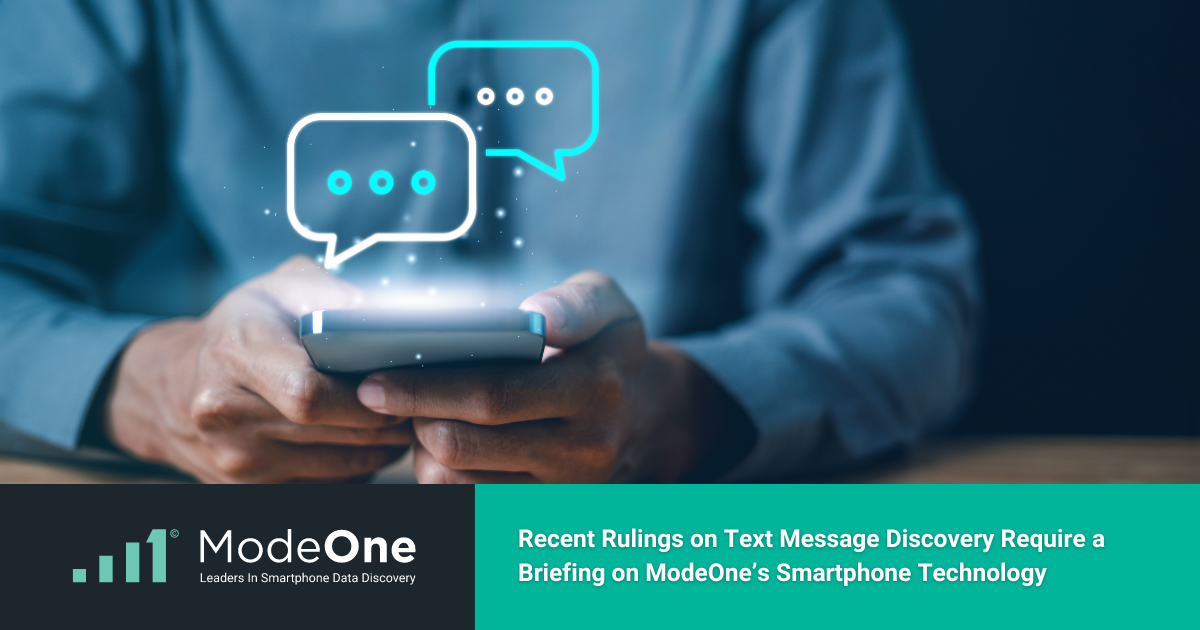Recent Rulings on Text Message Discovery Require a Briefing on ModeOne’s Smartphone Technology
Electronically stored information (ESI) on smartphones, particularly text message data, presents many challenges in e-discovery. The proliferation of ESI and the increased use of personal smartphones in the workplace have added layers of complexity that require our utmost attention and understanding.
Recent court rulings have underscored the urgent need to address the potential legal implications of business-related texts on personal devices. These texts could be within an organization’s possession, custody, and control and subject to the organization’s preservation obligations despite being on employee-owned smartphones. See, e.g., Goldstein v. Denner, 310 A.3d 548, 573 (Del. Ch. Jan. 26, 2024); Cap. Senior Living Inc. v. Barnhiser, No. 22-CV-00606, 2024 WL 278105, at *5 (N.D. Ohio Jan. 25, 2024).
The Sedona Principles: Rooted in the Past
The Sedona Principles, a practical framework addressing the distinct challenges of producing ESI, assert that “mobile devices that are not synchronized with the organization’s servers may necessitate physical collection of the mobile device to meet preservation or discovery obligations.” However, they also caution, “It may not be necessary to image the device if the costs, burdens, and other issues associated with imaging the device outweigh the benefits of retrieving unique, relevant ESI from the device.” This guidance serves as a crucial tool for legal professionals in navigating the complexities of ESI management. However, it is rooted in the technology available in the year of its publication: 2018. See “The Sedona Principles, Third Edition: Best Practices, Recommendations & Principles for Addressing Electronic Document Production,” 19 Sedona Conf. J. 1, 63 (2018).
Data on personal smartphones can be particularly troublesome in litigation involving corporate defendants because the custodian, not the organization, controls the device. This can lead to issues involving device and individual settings for storing information on the phone, such as auto-delete and upgrade settings.
In Goldstein v. Denner, the plaintiff alleged that the defendants engaged in insider trading concerning a proposed acquisition and served discovery seeking communications involving one of the principals who negotiated the transaction. However, the principal’s phone was not imaged or collected because the defendants’ general counsel informed their outside counsel that there was a policy against using text messages for business purposes and that the GC had looked through the principal’s text messages and found nothing responsive.
Only after the plaintiff received text messages from other parties involving the principal did outside counsel investigate the principal’s phone. By then, the principal claimed to have lost all his text messages when he upgraded his phone to a new model.
The Goldstein case and Cap. Senior Living Inc. v. Barnhiser, which found that a party had control over work-related text messages on a custodian’s personal phone, reflects the importance of considering ESI sources on personal smartphones early in litigation.
Recalculating Proportionality With ModeOne Smartphone Discovery
As noted above, ESI on personal smartphones can present unique challenges because the cost, burden, and other issues associated with collecting data may outweigh the benefits of collection. This is the crux of the proportionality rule in the Federal Rules of Civil Procedure Rule 26(b), outlining the scope of discovery: “Parties may obtain discovery regarding any nonprivileged matter that is relevant to any party’s claim or defense and proportional to the needs of the case, …, and whether the burden or expense of the proposed discovery outweighs its likely benefit.”
However, as recent decisions on discovering text messages on smartphones demonstrate, carefully balancing proportionality considerations is essential for the parties to determine what text message data should be preserved, collected, reviewed, and produced.
An inquiry into these questions should consider the custodian’s relevance to the dispute and the extent to which custodians used their mobile phones for business purposes. It should also consider the current technology for discovering text messages on smartphones. Using ModeOne, it is no longer burdensome to find relevant text messages on personal devices used for business purposes.
With ModeOne’s automated technology, parties can collect smartphone evidence anywhere worldwide with same-day service and target only relevant custodian data, ignoring private unrelated files. This changes the calculation of proportionality and whether the burden or expense of the proposed discovery outweighs its likely benefit.
Using ModeOne, the parties enjoy an easy, fast, secure, and economical experience. The privacy needs of data custodians are addressed, too—only relevant data is collected, preserving data privacy, and custodians never have to be without or away from their phones.
ModeOne’s remote, targeted collection solution eliminates needing a physical collection kit or onsite forensics technicians. It uses a patented, secure SaaS framework that captures, encrypts, and transmits the raw data to an ISO-certified data center, where it is ingested and processed, including logging, decryption, and extraction. Processed data is normalized and visually formatted for ease of review with role-based access controls. You can easily search, filter, and export the data into Relativity for expedited review.
Hat tip to Law360’s E-Discovery Quarterly Column for bringing this to our attention.
